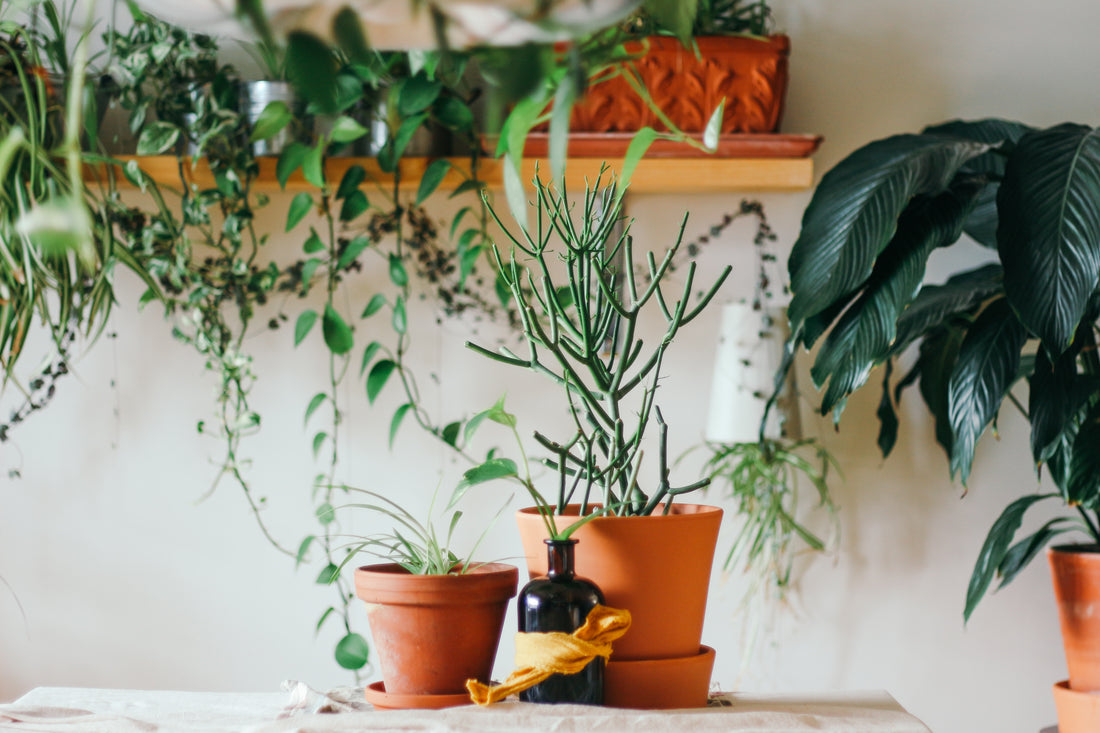Are your plants in the right soil? Do you leave your plants in the soil in which you bought them or do you repot them immediately? When you repot your plants, do you make sure you use a suitable potting soil? And which pots do you use? Terracotta, ceramic, plastic? Read our article to make sure you offer your plants the best environment for their growth.
Do you have the right pots and soil for your plants?
When you have plants at home, one of the essential things is to make sure they are in the right soil and in the right pot. A good soil and a good pot are the home of your plant, they are just as important as a good amount of light. We have spoken to Cécile d'Ortigreen to give you some good advice on how to make sure you have the right type of potting soil and to help you choose the right pots for your plants.
Our expert
Cécile comes from Paris. She has been a horticulturist for a few years, after a career change. Her hobby is substrates. She is therefore the right person to advise you on the different types of potting soil to use according to your plant varieties. For Cécile's sound advice, check out her Facebook page and her Instagram account.
Soil

What are the bases in terms of soil composition according to tropical plants, succulents, cacti (ratios of soil, perlite, compost to orchid, etc.)?
There are a few rules concerning the substrate: it must be sufficiently stable for the roots to develop. Then, its role is to constitute a reservoir for nutrients, provide water to the roots, and finally, oxygen.
I always advise to buy a good basic potting soil (I use the plagron Growmix), which is enriched with perlite. Basic potting soil should not be chosen in haste because the plant's evolution depends on the constitution of its soil and its ability to redistribute the elements necessary for its good development.
After that, it's cooking! I try to have the same amendment for all my houseplants except for cacti or orchids - which I don't have by the way. I mix equal parts potting soil/perlite and then I add other mineral-type components.
The aim is to recreate an aerated and perfectly draining substrate, close to the original one.
When you buy a plant, it is usually in a peat substrate, which is low in nutrients, but which is suitable for a short period of time for root development.
Should the soil be baked to prevent infestations? If so, what is the recipe?
I've never done it (I find it easier to change potting soil), but yes, it is possible to sterilize the substrate.
I know that it is advisable to sterilize the seeding substrate to avoid any infestation during emergence (melting of seedlings for example).
The recipe is simple :
- Place 1 kg of potting soil flat in a freezer bag,
- Add a large glass of water to bring the water for sterilisation.
- Microwave for 20 minutes at maximum power.
- Allow to cool before use
Is there any other treatment to be done?
When you use a quality soil, with good drainage and sufficient humidity with adequate watering and light, when your plant is not underfed and is regularly fertilized, it should be protected and in good shape.
I do not recommend chemical treatments. I favour the natural as much as possible. I am a great user of natural liquid manure such as nettle, which happens to be an excellent insecticide (aphids/mites...) as well as an effective fertilizer.
Be careful with variegated plants, however, because nettle liquid manure is rich in nitrogen, and therefore "green" growth is not recommended on variegated plants because of the risk of reversion (the plant turns green again).
When a plant is too much attacked by mites or thrips for example (and it is not your only plant), you have to know how to "let go". The risk that it will contaminate your other plants is sometimes greater than its chances of survival.
Very important! When you throw the "sick" plant away, do not throw it into the compost or into the wild, as this may re-contaminate the soil and create a "snowball" effect. It is best to "burn" the plant.
The pots

What are the qualities of the best pots to make our plants happy?
So the question of the pots is, according to my experiences, a question of season and the needs of the plant.
Clay pots
I favour terracotta pots for plants that need a lot of drainage, such as spiders, for my outdoor plants as well as for succulent or cactus plants. Yes, I do, Terracotta pots are porous and therefore allow water and air to circulate, which allows the roots to breathe better, but it also means that watering will have to be more frequent. This draining side is ideal for all plants that fear stagnant moisture. In addition, being heavier, they give a certain stability to plants whose large foliage could cause them to tip over in windy conditions.
Plastic pots
They're lighter than earthenware pots! I use them a lot for sowing or cutting. They are also easier to clean and disinfect to avoid transmitting diseases when repotting.
Watch out for the colour of your pot! Dark colours will heat up very quickly in the sun, risking burning the roots.
I will prefer plastic pots in the summer because they will keep moisture and freshness longer because they are waterproof, unlike clay pots. In winter, plants need less water, and more humidity unlike in summer.
Of course, they must have a hole to drain off the surplus! The advantage of the plastic pot is that you can also drill holes on the sides and thus better oxygenate the substrate and thus the roots.
From an aesthetic point of view, I realize that it is not very pretty in an interior, but I always prefer the comfort of my plant and then nothing prevents me from placing it in a beautiful cache pot (with a scrupulous control during watering to ensure that there is no water in the bottom of the cache pot). Then there's the ecological issue, and I try to ban plastic as much as possible, and today in France, it's difficult to buy a plant without a plastic pot, so I reuse the pots as much as possible, disinfecting them well beforehand. I also collect, here and there, pots ready to be thrown away.
How do you choose the size of your pot when repotting?
I repot according to the roots and their development.
Some plants like to be cramped in their pot, such as Sansevieria.
But as a general rule, Repotting is done when the roots start to get cramped, gradually increasing the pot size.
